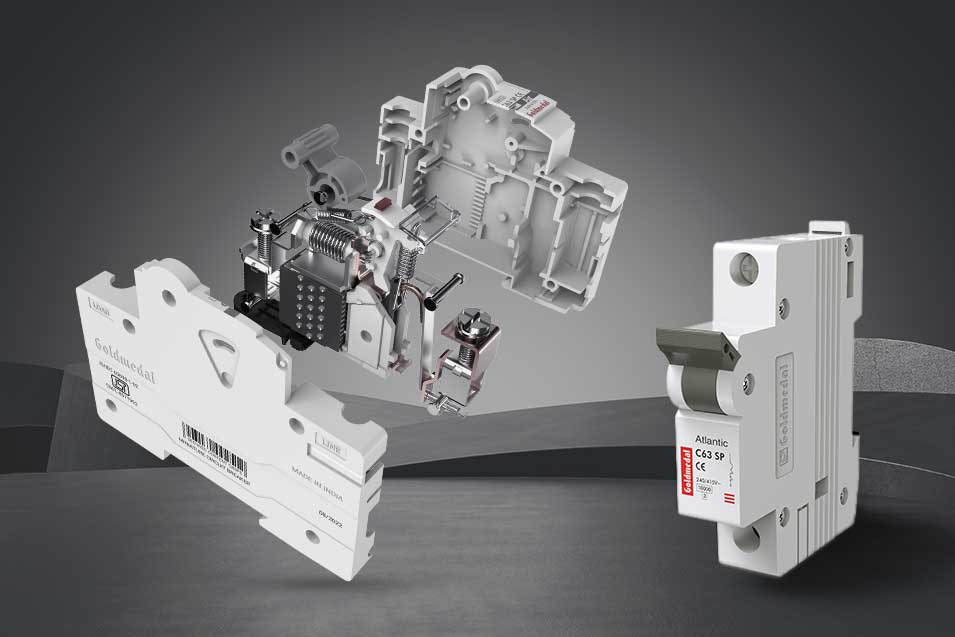
How to install an MCB in your house?
Miniature Circuit Breaker or MCB is a significant part of your electrical system in your office, home, or any other commercial set-up. They are responsible for safety during power surges that can be hazardous and threatening. Hence, proper installation of MCB is vital for reliable electrical systems. This blog will serve as your comprehensive guide to installing an MCB, covering everything from selecting the right breaker to wiring it correctly and safely.
Safety first
Before installing an MCB, prioritizing safety is essential. Always turn off the main power supply at the meter. Before beginning work, use a voltage tester to ensure that the circuit is dead. It is also recommended to wear safety gear, such as insulated gloves and protective eyewear.
Step 1 – Choosing the right MCB
MCBs come in various types, each designed for specific applications and offering varying levels of protection. It’s crucial to select an MCB that matches the circuit load it will protect. Consulting an electrician familiar with your home’s electrical layout can assist you in selecting the appropriate MCB.
You can also refer to the Blog on The Ultimate MCB buying guide to help you make the right choice.
Read: How To Choose An MCB?
Step 2 – Preparing the Distribution Board (DB)
Turn off the main power before opening the DB where the MCB will be installed. Usually, this board houses other circuit breakers or fuses. Identify a suitable location for the new MCB. If there’s no space, consider reorganizing or upgrading the board.
Step 3 – Wiring the MCB
First, remove the panel cover of the DB. Now, securely slot the MCB into its position on the board. Next, use a wire stripper to prepare the ends of the live (usually red or brown) and neutral (blue or black) wires. Connect the live wire to the MCB’s live terminal and the neutral wire to the neutral bar in the board, ensuring all connections are tight and secure.
Step 4 – Testing
After securing all connections, replace the distribution board cover and turn on the main power supply. Now, it’s time to test the newly installed MCB. Gently switch on the MCB; this action should activate the connected circuit, making it live. For a final safety check and to confirm the correct installation, use a voltage tester on the circuit. This step is essential to verify that the circuit is functioning correctly and safely, ensuring that the MCB is effectively providing protection as intended.
Step 5 – Labelling & documentation
Finally, label the new MCB on the distribution board for easy identification in the future. It’s also good practice to update any electrical circuit diagrams you have for your home.
Follow the steps mentioned above to install the MCB. However, this has to be done very carefully, as working with electricity can be dangerous. For safety, consider having the installation performed by a professional electrician. Always remember, safety with electricity is the most important consideration.
Frequently Asked Questions (FAQs) :
Q1. How do I choose the right MCB for my house?
To choose the right MCB for your house, calculate your total connected load, select the appropriate amperage rating, consider circuit types, and ensure compliance with electrical codes. Consulting an electrician for guidance is advisable to ensure safety and proper functionality.
Q2. Can I install multiple MCBs in my house?
Yes, you can install multiple MCBs in your house, and it’s often necessary to distribute electrical loads efficiently. Each MCB can protect different circuits or areas of your home, enhancing safety and control over individual circuits.
Q3. What should I do if the MCB keeps tripping frequently?
If your MCB keeps tripping frequently, it indicates an electrical issue. First, identify and unplug any faulty appliances or devices causing the overload. If the problem persists, consult a qualified electrician to inspect your electrical system, as frequent tripping may be due to a more significant underlying problem that needs professional attention.
Q4. Is it possible to install an MCB without professional help?
Yes, it is possible to install an MCB without professional help if you have electrical knowledge and experience. However, if you are uncertain about any aspect of the installation or electrical systems, it’s strongly recommended to seek the assistance of a qualified electrician to ensure safety and compliance with local regulations.
Q5. How often should MCBs be replaced?
MCBs typically have a long lifespan and don’t need frequent replacement under normal operating conditions. However, it’s a good practice to have them inspected by a qualified electrician periodically to ensure they are functioning correctly.
Q6. Can I upgrade my MCB for additional safety?
Yes, you can upgrade your MCB for additional safety by choosing a higher-rated MCB or one with a more sensitive tripping curve to enhance protection against overloads and short-circuits. However, it’s essential to ensure that the upgraded MCB is compatible with your electrical system and complies with local electrical codes.

